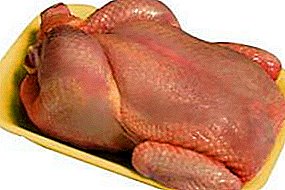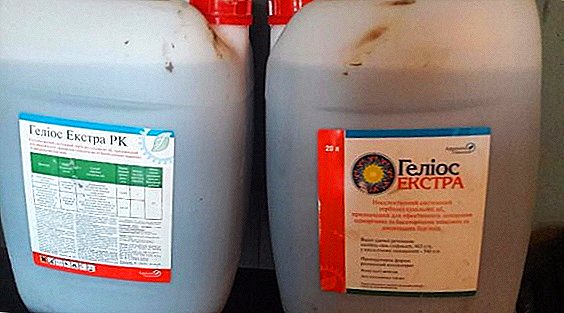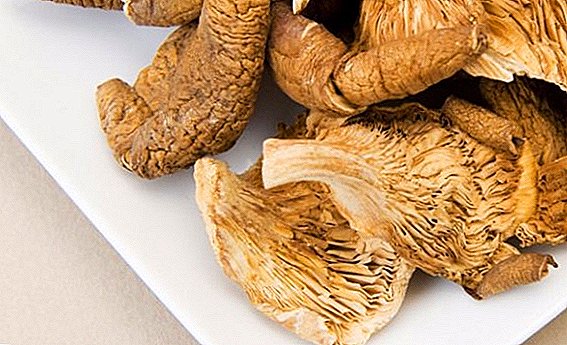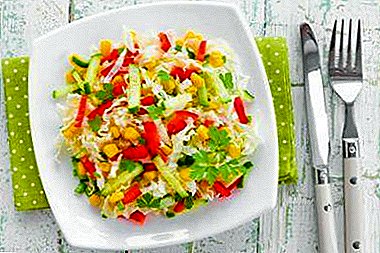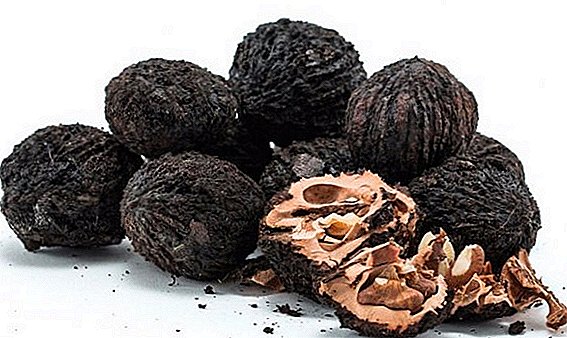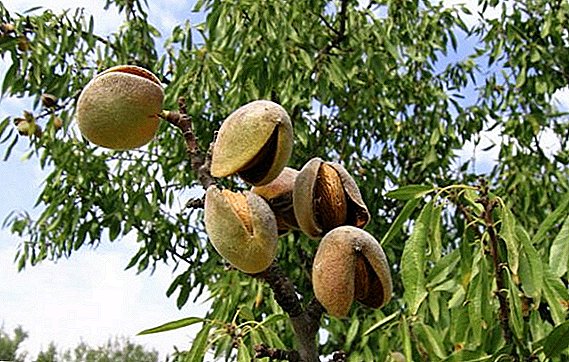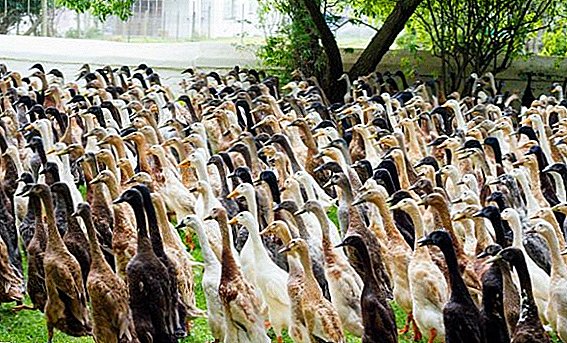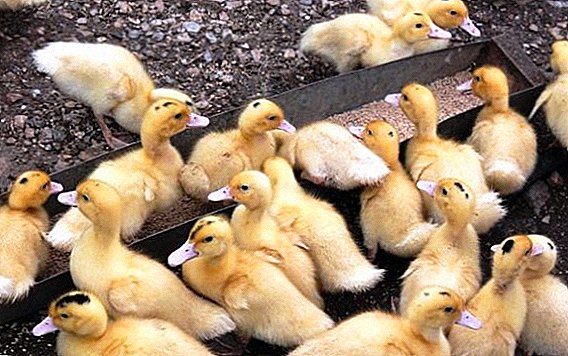 Feeding ducklings in the first weeks after birth is quite troublesome. In this article we will describe how to effectively organize the care of small ducklings, discuss the feeding habits of chicks at different ages.
Feeding ducklings in the first weeks after birth is quite troublesome. In this article we will describe how to effectively organize the care of small ducklings, discuss the feeding habits of chicks at different ages.
Also consider what exactly feed ducklings at home from the first days of their lives.
Conditions for content
The main point in the breeding of ducklings in the first weeks is the optimal uniform temperature in the cells that contain the young. The temperature regime during the heating period must be maintained within the following framework: at the age of 1 to 5 days - 28-29 ° C, from 6 to 10 days - 25-27 ° C, from 11 to 20 days - 22-25 ° C, s 21 days to a month - 21-18 ° С.  It is important for beginning specialists in the field of breeding ducklings at home to understand that in order for poultry to develop properly, it is especially important to avoid night temperature fluctuations. Make sure that the yellow-haired people do not pile up overnight, but are evenly placed near the heat source.
It is important for beginning specialists in the field of breeding ducklings at home to understand that in order for poultry to develop properly, it is especially important to avoid night temperature fluctuations. Make sure that the yellow-haired people do not pile up overnight, but are evenly placed near the heat source.
Landing density also plays a big role. On 1 square meter of floor space of the cage you can place no more than 40 heads.
For ground cages, use chopped straw or peat. The litter should be dry and free from mold and dust. Sprinkle the floor of the cells with dry sand, then lay a straw 5-8 cm thick. Shake the litter daily, clean the litter.  Remove contaminated or damp litter and replace with fresh litter. The air in the chicks should always be clean. Ventilate the room regularly, while avoiding drafts.
Remove contaminated or damp litter and replace with fresh litter. The air in the chicks should always be clean. Ventilate the room regularly, while avoiding drafts.
From the third day chicks can already be released for walking. At the same time, the outdoor temperature should not be lower than 15-18 ° C. Extend the time of chicks on the walk gradually. Up to 25 days to let out kids on water runs should not be.
Learn about the conditions and timing of growing ducklings in an incubator.Runs should be carried out in due conditions. For the proper development of ducklings it is necessary to provide them with direct sunlight. At the same time, chicks should be able to hide in the shade so that they will not suffer from prolonged exposure to the scorching sun.
Water in drinking bowls put in the shade, in any case not in the sun. In addition, the water should always be fresh and clean.  Protect chicks from rain, as they quickly become wet and may die. Do not let the little ducklings wet the grass from the dew and rain.
Protect chicks from rain, as they quickly become wet and may die. Do not let the little ducklings wet the grass from the dew and rain.
Important! In the event that chicks get wet from rain or other causes, take steps to duck the duck rather dry.
How to teach ducklings to eat
It is important not only to know what to feed the little ducklings at home, but also to teach them to eat.
To begin to feed the chicks from the pipette with a weak solution of potassium permanganate. Next, on a sheet of paper in a green shade, lay a soft boiled egg mixed with any cereal.  You can also put food in a wide container with low sides and knock on the bottom with your finger - the birds instinctively start repeating movements.
You can also put food in a wide container with low sides and knock on the bottom with your finger - the birds instinctively start repeating movements.
To teach inexperienced chicks to recognize feed at the initial stage is well helped by the old grandfather's technique. Pour the mixture of food on the backs of the chicks. When falling on the ground, the food particles imitate movement, which attracts the ducklings and encourages them to eat.
Did you know? It is known that according to the laws of physics, any sound is reflected under certain conditions. However, oddly enough, duck quacking is not subject to this law, it has no echo at all. Wherever this waterfowl quacks, you will not hear any echo.Toddlers learn to hunt moving food. The effectiveness of this method is due to the fact that food, according to waterfowl, should move.

Make up the diet
Making a diet for little ducklings is not particularly difficult. However, consider some of the nuances. For example, for what purposes the bird is raised, how quickly you want to feed them. Also in the preparation of the diet, note the characteristics of the duck breed.
You will be interested - the most popular breed of ducks and rules for breeding at home.
Up to 10 days
The first 10 days of chicks should be fed little by little, but often, at regular intervals, at least 8 times a day. So, consider how to feed daily ducklings at home.
In the first 10 days after birth, focus on protein feed. Feed the chicks with boiled, peeled and minced eggs (chicken or duck). For a couple of days with eggs, give the kids some corn, as well as oatmeal and barley groats.  Then add to the diet milk, cottage cheese (fat-free), kefir and other dairy products. On each head, include in the diet of 5 g of cottage cheese.
Then add to the diet milk, cottage cheese (fat-free), kefir and other dairy products. On each head, include in the diet of 5 g of cottage cheese.
Do not forget from the 6th day to add concentrates of vitamins A and D to the mash beans. This contributes to the good development of waterfowl and rapid weight gain.
The composition of the food for little ducklings up to 10 days:
- crushed grain - 15 g;
- greens - 20 g;
- boiled shredded egg - 3 g;
- low-fat cottage cheese - 3 g;
- wheat bran - 5 g;
- soybean meal - 1 g;
- boiled meat waste - 3 g;
- chalk - 1 g;
- bone meal - 0.5 g;
- feed yeast - 0.2 g

10-20 days
Next, consider what you can feed the ducklings 1-3 weeks of age at home. First of all, from the 11th day you should reduce the number of feedings. Ducklings should be fed 4-5 times a day.
Important! Sometimes breeders mistakenly add bread to the ducklings. Such feed is incorrect. This product may lead to undesirable fermentation reactions in the stomach of chicks, which may further lead to their death.Feed the chicks with boiled root vegetables and potatoes. Also add to the diet wet mash on the basis of crushed grain or bran. Knead the mixes on the milk. The resulting composition should not be sticky, pasty or too liquid.
 Also during this growing period, begin to teach chicks to green food. Shredded fresh nettle is perfect for this purpose. Grind the nettles in advance and add to the eggs or cottage cheese.
Also during this growing period, begin to teach chicks to green food. Shredded fresh nettle is perfect for this purpose. Grind the nettles in advance and add to the eggs or cottage cheese.Until the chicks are 20 days old, remove the shells from the barley and oatmeal.
Familiarize yourself with such representatives of duck breeds as the mulard, the Bashkir ducks, the Star 53 broiler duck, Peking ducks, and the blue favorite.The composition of complete dry combined feed (per 100 g of feed):
20-30 days
From the 20th day to the age of one month, follow the 3-fold feeding.
- wheat - 47 g;
- corn - 10 g;
- barley - 15 g;
- sunflower meal - 9 g;
- fodder yeast - 7 g;
- shells, chalk - 2 g;
- salt - 0.1 g
 As soon as your pets are 20 days old, feed them with waste from the kitchen, garden and vegetable garden. Yeast in the diet of ducklings are considered an important element.
As soon as your pets are 20 days old, feed them with waste from the kitchen, garden and vegetable garden. Yeast in the diet of ducklings are considered an important element.Also take care of mineral feeds, such as sand, shellfish and gravel. Chicks should always have access to them.
Option balanced feed for ducklings 3-4 weeks of age:
- wheat - 49 g;
- corn - 10 g;
- barley - 16.5 g;
- sunflower meal - 7 g;
- fodder yeast - 4 g;
- fish meal - 7 g;
- grass meal - 4 g;
- shells, chalk - 1.4 g;
- salt - 0.1 g

Nutrition features of meat breeds
In spite of the fact that there are legends about omnivorous ducks, it is necessary to approach the early feeding of meat breeds with all responsibility. The health and productivity of the future livestock will depend on how faithfully the feeding of young stock will be arranged.
It will be useful for you to learn about the rules of feeding musk ducks.When fattening with wet mash, make sure that the chicks eat the whole feed at a time, otherwise the feed mixture will stagnate and spoil. Dry food, on the contrary, should be given with an excess.
Applying oats or barley to fatten little ducklings, sift grains in addition. Then soak fresh low-fat cottage cheese and add to the grain mixture. Add dairy products to the feed only in a fermented form.  Fresh milk (especially domestic) can lead to disorder of the gastrointestinal tract or become a source of dangerous ailments.
Fresh milk (especially domestic) can lead to disorder of the gastrointestinal tract or become a source of dangerous ailments.
Did you know? Ducklings are smarter than we could have imagined. Scientists from the University of Oxford Anton Martinu and Alex Kaselnik demonstrated the mechanism of the duckling brain as a result of the experiment. Newborn birds tested tested their abilities for abstract thinking.As you can see, the care of newborn ducklings is the most difficult moment in the breeding of this bird. However, with proper feeding and proper maintenance, the bird will be healthy and quickly gain the necessary weight.


